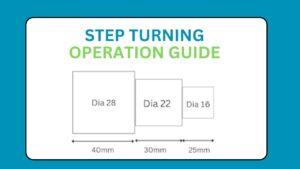Introduction :
In this article, we will learn about step turning operation definition, how to perform step turning operation, and the whole lab work is explained step turning aim, step turning apparatus, and procedure to complete step turning operation, and more
What is Step turning operation?
Step turning operation is a type of turning operation in which a series of steps are created on the surface of the workpiece.
This is done by adjusting the position of the cutting tool during the turning operation. Step turning is commonly used in the production of parts that require a series of stepped surfaces.
when do we prefer step turning operation?
Complex Geometries: Step turning is ideal when the product requires features such as steps, tapers, shoulders, or grooves on its surface.
Multi-Diameter Parts: When a product involves multiple diameters along its length, step turning allows for the efficient machining of these diameters in a single setup, reducing production time and costs.
Precision Requirements: Products that require precise control over dimensions and tolerances benefit from step turning’s ability to achieve high accuracy and quality finishes.
Efficiency: Step turning is preferred when efficiency in machining processes is crucial, as it streamlines production by reducing the number of setups and machining operations required.
Surface Finish: For products requiring smooth and uniform surface finishes, step turning ensures consistent results without the need for additional finishing processes.
Cost-Effectiveness: Step turning helps in cost reduction by minimizing labor, material waste, and setup time, making it suitable for mass production of parts with complex geometries.
How to perform Step turning operation on lathe machine:
lets look at the guide to perform step turning operation on lathe machine

Aim :
To perform the step-turning operation to produce a well-finished step-turned product
The material used :
Ms round bar dia 30 x100mm
Equipment Used :
lathe machine fitted with 3 Jaw self-centering
Tool required:
- Turning tool
- parting tool
- Vernier caliper
The procedure:
- fix the workpiece in 3 Jaw chuck
- face the ends
- Turn to dia 28 mm by taking a number of turns recommended to have a depth of cut of 0.5mm in each turn of the turning operation
- Measuring the diameter with a vernier caliper
- Using a parting tool, make a groove of width 3mm and 8mm deep
- Turn to dia 22 mm from the end to a length of 5omm by taking the depth of cut (feed) of 0.5mm each time
- Measure dia 22mm by vernier caliper
- Using the parting tool make a groove of a width of 5mm and a depth
- Turn the dia 16mm from the end up to a length of 26mm by taking the depth of cut (feed) 0.5mm each time
- Meaning the dia 16mm by vernier caliper
- Round of Sharp Edge
- Remove the job and hold it on dia 22mm by the end and the jaw chuck
- Do forcing operation until we achieve the final length as per the drawing
- Do turning operation to dia 28 according to drawing
- Round of sharp edge.
Watch this video to get proper visual understanding of step turning operation
Precautions of step turning operation:
- Wear Safety devices like goggles and an apron
- Follow construction about safety working on lathe given Separately
- check dia with the vernier caliper at the end run of the turning operation until the desired dimension is reached
- Make Sure that the tools are Sharpened before the start of each operation
The Final product of the step turning operation:
|
| Step turning operation on lathe machine |
Interference
The lathe is a versatile machining for performing operations like facing, turning, grooving, etc.
Follow us on Facebook page to stay connected alsp read more blogs from Home page
Advantages of step turning operation:
Versatility: Step turning is a versatile machining operation capable of producing various geometries and features, including steps, tapers, shoulders, and grooves.
Efficiency: It allows for the production of complex parts with multiple diameters in a single setup, reducing the need for multiple machining operations and setups.
Precision: Step turning enables precise control over dimensions and tolerances, ensuring high accuracy and quality in the finished parts.
Cost-effectiveness: By reducing the number of machining operations and setups required, step turning can lead to cost savings in terms of labor, time, and materials.
Improved Surface Finish: It allows for the attainment of smooth and uniform surface finishes, meeting the requirements of various applications without the need for additional finishing processes.
Enhanced Productivity: Step turning increases productivity by streamlining the manufacturing process, reducing idle time between setups, and minimizing material waste.
Reduced Lead Time: With its ability to produce multiple features in a single setup, step turning can shorten lead times for part production, meeting tight deadlines and increasing overall efficiency.



If anyone with any doubt feel free to comment on